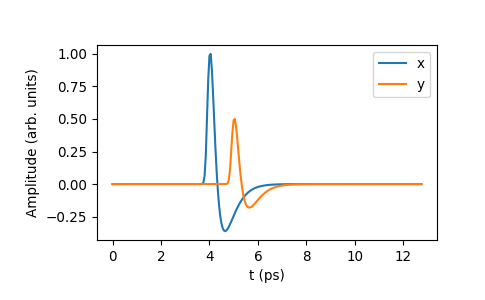thztools.apply_frf#
- thztools.apply_frf(frfun, x, *, dt=None, numpy_sign_convention=True, args=())[source]#
Apply a frequency response function to a waveform.
- Parameters:
- frfuncallable
Frequency response function.
frfun(omega, *args) -> ndarraywhere
omegais an array of angular frequencies andargsis a tuple of the fixed parameters needed to completely specify the function. The units ofomegamust be the inverse of the units ofdt, such as radians/picosecond.- xarray_like
Data array.
- dtfloat or None, optional
Sampling time, normally in picoseconds. Default is None, which sets the sampling time to
thztools.options.sampling_time. If bothdtandthztools.options.sampling_timeareNone, the sampling time is set to1.0. In this case, the angular frequencyomegamust be given in units of radians per sampling time, and any parameters inargsmust be expressed with the sampling time as the unit of time.- numpy_sign_conventionbool, optional
Adopt NumPy sign convention for harmonic time dependence, e.g., express a harmonic function with frequency \(\omega\) as \(x(t) = a e^{i\omega t}\). Default is
True. When set toFalse, uses the convention more common in physics, \(x(t) = a e^{-i\omega t}\).- argsarray_like, optional
Extra arguments passed to the frequency response function. All elements must be real quantities.
- Returns:
- yndarray
Result of applying the frequency response function to
x.
- Warns:
- UserWarning
If
thztools.options.sampling_timeand thedtparameter are both notNoneand are set to differentfloatvalues, the function will set the sampling time todtand raise aUserWarning.
See also
fitFit a frequency response function to time-domain data.
Notes
The output waveform is computed by transforming \(x[n]\) into the frequency domain, multiplying by the frequency response function \(H[n]\), then transforming back into the time domain.
\[y[n] = \mathcal{F}^{-1}\{H[n] \mathcal{F}\{x[n]\}\}\]Examples
Apply a frequency response function that rescales the input by \(a\) and shifts it by \(\tau\).
\[H(\omega) = a\exp(-i\omega\tau).\]Note that this form assumes the \(e^{+i\omega t}\) representation of harmonic time dependence, which corresponds to the default setting
numpy_sign_convention=True.>>> import numpy as np >>> import thztools as thz >>> from matplotlib import pyplot as plt >>> n, dt = 256, 0.05 >>> t = thz.timebase(n, dt=dt) >>> x = thz.wave(n, dt=dt) >>> def shiftscale(_w, _a, _tau): ... return _a * np.exp(-1j * _w * _tau) >>> >>> y = thz.apply_frf( ... shiftscale, x, dt=dt, numpy_sign_convention=True, args=(0.5, 1) ... )
>>> _, ax = plt.subplots() >>> >>> ax.plot(t, x, label="x") >>> ax.plot(t, y, label="y") >>> ax.legend() >>> ax.set_xlabel("t (ps)") >>> ax.set_ylabel("Amplitude (arb. units)") >>> plt.show()

If the frequency response function is expressed using the \(e^{-i\omega t}\) representation more common in physics,
\[H(\omega) = a\exp(i\omega\tau),\]set
numpy_sign_convention=False.>>> def shiftscale_phys(_w, _a, _tau): ... return _a * np.exp(1j * _w * _tau) >>> >>> y_p = thz.apply_frf( ... shiftscale_phys, x, dt=dt, numpy_sign_convention=False, args=(0.5, 1) ... )
>>> _, ax = plt.subplots() >>> >>> ax.plot(t, x, label="x") >>> ax.plot(t, y_p, label="y") >>> >>> ax.legend() >>> ax.set_xlabel("t (ps)") >>> ax.set_ylabel("Amplitude (arb. units)") >>> >>> plt.show()
